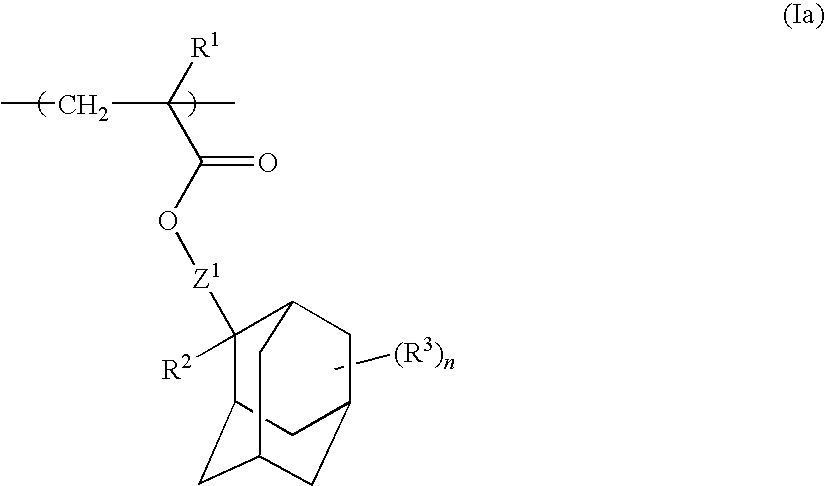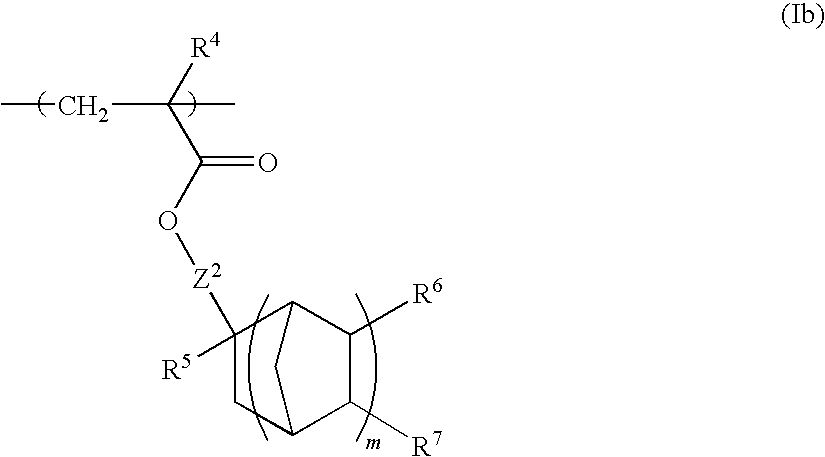Chemically amplified positive resist composition
- Summary
- Abstract
- Description
- Claims
- Application Information
AI Technical Summary
Benefits of technology
Problems solved by technology
Method used
Image
Examples
synthesis example 1
Resin Synthesis Example 1
Synthesis of Resin B1
[0163]Into a four-necked flask equipped with a thermometer and a reflux condenser, 16.3 parts of 1,4-dioxane was charged and a nitrogen gas was blown into it for 30 minutes. Under a nitrogen gas atmosphere, a mixture obtained by mixing 0.16 part of monomer A, 24 parts of monomer B, 3.48 parts of monomer C, 3.7 parts of monomer D, 0.45 part of 2,2′-azobisisobutyronitrile and 65.19 parts of 1,4-dioxane (monomer ratio; monomer A: monomer B: monomer C: monomer D=1:70:14:15) was added dropwise thereto over 1 hour at 86° C. The resultant mixture was heated at 86° C. for about 5 hours. The reaction mixture was cooled and poured into 815 parts of n-heptane with stirring. The precipitated resin was isolated by filtration and washed three times with 407 parts of n-heptane. The resin obtained was dried under reduced pressure to obtain 32.5 parts of the resin having a weight-average molecular weight (Mw) of 33,300 in a yield of 99%. The ratio of wei...
synthesis example 2
Resin Synthesis Example 2
Synthesis of Resin A1
[0171]Into a four-necked flask equipped with a thermometer and a reflux condenser, 70.91 parts of methyl isobutyl ketone was charged and a nitrogen gas was blown into it for 30 minutes. Under a nitrogen gas atmosphere, a mixture obtained by mixing 30 parts of monomer E, 14.27 parts of monomer F, 10.28 parts of monomer G, 0.79 part of 2,2′-azobisisobutyronitrile and 70.19 parts of methyl isobutyl ketone (monomer ratio; monomer E: monomer F: monomer G=50:25:25) was added dropwise thereto over 1 hour at 86° C. The resultant mixture was heated at 86° C. for about 5 hours. The reaction mixture was cooled and poured into 815 parts of n-heptane with stirring. The precipitated resin was isolated by filtration and washed three times with 407 parts of n-heptane. The resin obtained was dried under reduced pressure to obtain 25.4 parts of the resin having a weight-average molecular weight (Mw) of 9,400 in a yield of 55%. The ratio of weight-average ...
synthesis example 3
Resin Synthesis Example 3
Synthesis of Resin B2
[0173]Into a four-necked flask equipped with a thermometer and a reflux condenser, 16.32 parts of 1,4-dioxane was charged and a nitrogen gas was blown into it for 30 minutes. Under a nitrogen gas atmosphere, a mixture obtained by mixing 0.33 part of monomer A, 21.3 parts of monomer B, 7.2 parts of monomer C, 2.56 parts of monomer D, 0.47 part of 2,2′-azobisisobutyronitrile and 65.29 parts of 1,4-dioxane (monomer ratio; monomer A: monomer B: monomer C: monomer D=2:60:28:10) was added dropwise thereto over 1 hour at 86° C. The resultant mixture was heated at 86° C. for about 5 hours. The reaction mixture was cooled and poured into 816 parts of n-heptane with stirring. The precipitated resin was isolated by filtration and washed three times with 408 parts of n-heptane. The resin obtained was dried under reduced pressure to obtain 28.2 parts of the resin having a weight-average molecular weight (Mw) of 24,700 in a yield of 90%. The ratio of ...
PUM
| Property | Measurement | Unit |
|---|---|---|
| Fraction | aaaaa | aaaaa |
| Fraction | aaaaa | aaaaa |
| Fraction | aaaaa | aaaaa |
Abstract
Description
Claims
Application Information
 Login to View More
Login to View More - R&D
- Intellectual Property
- Life Sciences
- Materials
- Tech Scout
- Unparalleled Data Quality
- Higher Quality Content
- 60% Fewer Hallucinations
Browse by: Latest US Patents, China's latest patents, Technical Efficacy Thesaurus, Application Domain, Technology Topic, Popular Technical Reports.
© 2025 PatSnap. All rights reserved.Legal|Privacy policy|Modern Slavery Act Transparency Statement|Sitemap|About US| Contact US: help@patsnap.com



